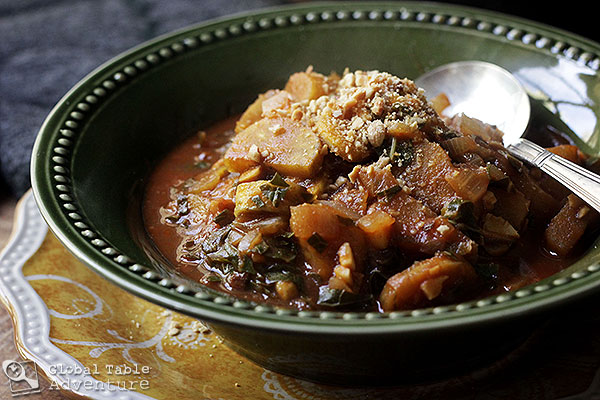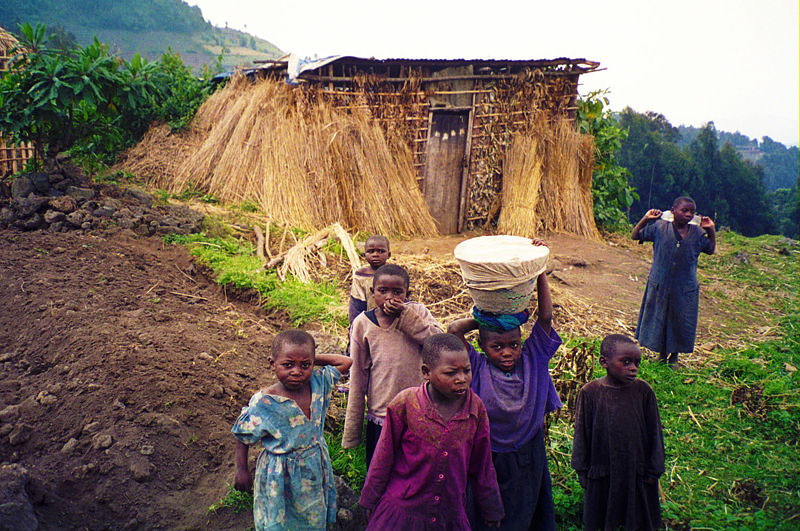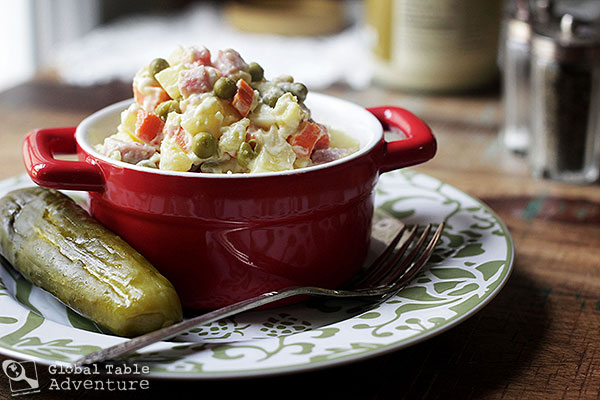I love the Caribbean. Seems like she always shows up when I need her most. Case in point? I spent the last week in NYC under rain, sleet, and snow. While I relished each snowflake through Ava’s eyes, the air was coat-clenching chilly. By the end of the week, we all huddled together around a table in Brooklyn while eating Saint Kitts & Nevis. And we were all warmed. From the inside out. Only after our feast, did I learn that Christopher Columbus named Nevis after our Lady of the Snows. Apparently her mountain peak is often shrouded in fluffy white clouds, giving the allusion of a true snow-capped mountain. Perfect. Just perfect. This enchanting name is just the beginning of St. Kitts & Nevis’ charm. With cheerful festivals and sunny days, the islands seem to float along as if in a dream. When it comes to food, here’s what you can expect from this beautiful pair of islands… Let’s start with the obvious – fish. Lots and lots of fish, like coconut crusted mahi-mahi …
Read More

We officially have less than a year remaining in this Adventure. Unbelievable. In the very beginning (February 2010), our Global Table Adventure was about eating a better, more varied diet, especially for our then seven-month old baby, Ava. Cooking the world was also about making life in Tulsa a little more tolerable, while daydreaming about other places. I was escaping. Hard. Now? Well the name is the same, but the Adventure has evolved in ways I could have never anticipated. Izína sí lyó muntu. This Rwandan saying means that “the name doesn’t make the man.” Or in this case, the “Adventure.” Case in point, Global Table Adventure is a nice name, but it doesn’t reveal much about the long years we’ve lived with this challenge. It doesn’t say anything, for example, about how appreciating the rest of the world has really made us appreciate our home more. Sometimes you have to look far to find the treasure on your own doorstep. Nor does the name hint at the community we enjoy around us. We learned an especially …
Read More
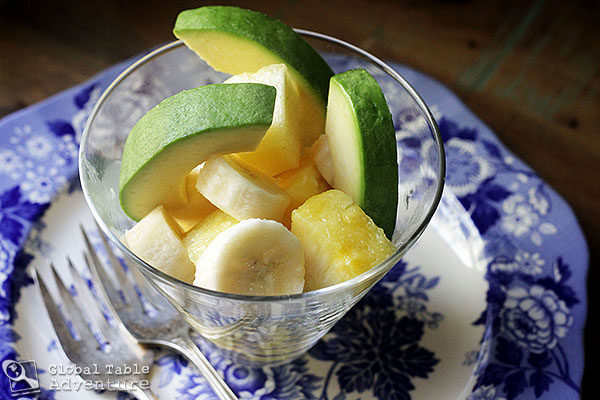
We may be in the heart of autumn here in Tulsa, Oklahoma, but no celebration of Rwanda is complete without a sliver of tropical fruit. This is the most popular way to end in a meal in Rwanda. Varieties include mango, pineapple, papaya, passion fruit, banana, and even buttery avocado: Although Mukamana says she and her husband cannot afford to purchase all the fruits needed to make a salad every day, they buy enough produce to make sure everyone at home eats a banana, an orange, or a piece of pineapple after every meal. (USAID) From what I hear, one piece is enough in Rwanda. The fruit, fresh and thick from growing in the humming, humid tropical air, is lusciously sweet. Each bite hangs heavy in the mouth. Ingredients: banana pineapple avocado mango papaya passion fruit Method: NOTE: There’s no right or wrong way to make a fruit salad, but if the weather is chilly where you live, you might be best off sticking to bananas. Unlike more temperamental mangoes and papayas, bananas seem to …
Read More

Sweet potatoes are up there with a good hair cut, purring cats, and sunlight through fiery autumn leaves. The simple sweetness is all I need on a chilly evening. But it’s not all about the coppery hued variety, which litter my counter tops like fallen leaves. There’s such a thing as white sweet potatoes, too. Rwandans love sweet potatoes, especially white sweet potatoes which they boil, mash, and even fry. I first saw this in action on the a Peace Corps blog En Route Rwanda: With help from some of our house mates and dinner guests, we peeled and sliced several kilos of knobby white sweet potatoes, which Zilpa then spent hours double-frying on the second charcoal stove. According to the Rwanda Agricultural Research Institute: Sweet potato is a major staple food in Rwanda and one of the second largest produces in terms of tons after bananas. The ability of sweet potato to adapt to a wide range of growing conditions, in both fertile and marginal areas, as well as its rapid growth rate as a ground cover to …
Read More
There’s an old Rwandan saying “The most extensive land is the human belly.” I like to think there’s mountains and streams in there, glorious sunsets and easy, glimmering sunrises. Is that somehow unsavory? I don’t know. I do know I want this land to be vast, and include as much variety as possible. I want to fit the whole world in there. And this, my friends, includes the plantain. Plantains have been an issue for my family from the beginning. Ava isn’t really keen on them (or bananas). Mr. Picky has consistently pushed aside his in favor of other foods (except for that time I made Plantain Chips with Sea Salt for Panama and that other time I used them as a butter-fried cheese wrapper, a.k.a. tortas de plantano). It’s time for us to love the plantain, after all they are the starchy cousin to the banana, but more savory and filling. For this reason, they are an important staple all over the tropical regions of the world. Plantains fruit all year round, which makes the crop …
Read More

Today is one of those days. I feel like singing. You see,sometimes a country is so far from anything I know, I have no idea what to expect. Then a meal like this happens. Fun. Interesting. Satisfying. With each bite we’re a little closer to our friends across the deep, salty blue. This is Rwanda: simple food, full of cozy comfort. Each item on the menu is a regular staple, from the bananas to the plantains, and from the sweet potatoes and to the crushed peanuts. Let the warmth carry you through the blustery chill, all the way to the other side of winter. P.S. Consider enjoying this meal lakeside, as though you were in Rwanda. P.P.S. If you can include a gorilla in your company, even better. Rwanda is known for her beautiful Mountain Gorillas. All recipes and the meal review will be posted throughout the week. Vegetarian Agatogo with Collard Greens [Recipe] A nutritious and satisfying stew of plantains and collard greens simmered with tomatoes, onions, and garlic. Finished with a sprinkling of crushed peanuts. …
Read More
I’m writing about Rwanda while sitting in the airport, on my way to New York City. Big things are in the works, and I can’t wait to tell you all about them. This is a fertile time for creativity, which makes Rwanda the perfect week to accompany me on this journey. The earth in this small, but sprawling country is so fertile, I’ve read you can stick a carrot top in the ground and carrots will grow. That’s the kind of good, growing energy I need right now. This is the center of Africa, along the rippling waters of Lake Kivu. Everyone, everywhere in Rwanda, seems to love the sweet potato [Recipe]and that’s a lot of people. Rwanda is one of the most crowded places in Africa. Avocados hang heavy on the trees, and cassava grows strong in the soil. Beans are the go-to, as is umutsima (cassava and corn porridge), fish from the lakes (like tilapia), and plantains. Very little meat is eaten, although what is enjoyed includes chicken, beef, and goat, and may be stewed …
Read More

This week we took the Russian Potato Salad to a potluck event in downtown Tulsa called “Open Tables” where individuals of different religions and belief systems gather to share food and company. It was my first time. While the discussion would have been fascinating (we were encouraged to talk about our differences), my table – through a series of prior commitments, baby bedtimes, and no shows – had completely vacated by the time discussion started. And so it came to be that, while the room chattered on, I sat alone at my table, thinking about the evening, staring at my empty plate. I briefly considered switching tables to join another group but the longer I sat there, the more I realized that the food had already done the job – no words were necessary to learn about our differences. Earlier that evening I had slipped our potato salad into the mix between a giant steaming bowl of biryani, spicy chickpeas, cinnamon-laced kugel, and goat stew. The variety was intoxicating. As I filled my plate, a casserole of neon green lime …
Read More
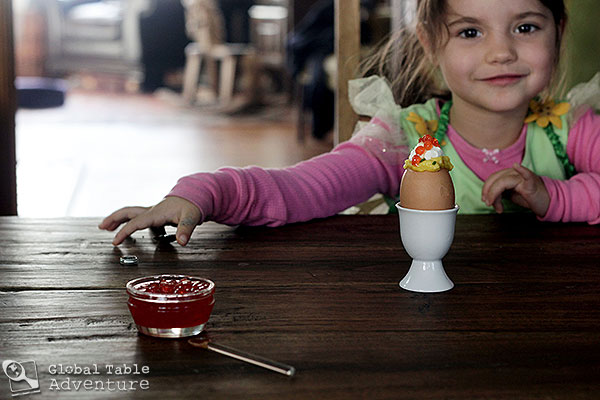
The scrambled eggs in Russia are so moist and creamy, you’d swear there’s cheese folded up inside. To achieve this texture, the eggs are never whisked or salted at this stage, but broken directly into a pot (not a pan), then cooked over gentle heat in a “on again, off again” game that makes Ross and Rachel’s relationship on Friends look stable. Finally, a generous swoosh of heavy cream and a sprinkle of seasoning finishes the eggs off right. Then, while they’re still steaming hot, you slide them inside a hollowed out egg shell. Even with all this glamour, it’s the glimmering, shimmering egg topper that really steals the show: the caviar (a.k.a. more eggs). Caviar is Russia’s love. To give you an idea of how precious these fish eggs are, imagine spending $8,000 on a pound of anything. Well-to-do Russians are happy to spend that much per pound on caviar. Thankfully for the wallet, one only eats an ounce or two in one sitting. I got the idea for today’s recipe from Andrew Zimmern. Here’s how they …
Read More
If you want to try something uniquely Russian (at least, I’d never heard of it until this week), try a cup of nice, black tea with a spoonful of fruit jam stirred in. Tea is the national drink of Russia, while the jam is a happy bonus. If you’re serving to more than one, be sure to brew the tea extra strong. According to Wikipedia: A notable feature of Russian tea culture is the two-step brewing process. Firstly, tea concentrate (Russian: заварка) is prepared: a quantity of dry tea sufficient for several persons is brewed in a small teapot. Then, each person pours some quantity of this concentrate into the cup and mix it with hot water; thus, one can make one’s tea as strong as one wants, according to one’s taste. Sugar, lemon, honey or jam can then be added freely. Even with the jam, a cube (or three) of sugar is optional, but recommended. So what’ll it be? Raspberry jam? What about cranberry? Or sour cherry? Whatever you choose, you’ll be well on your …
Read More
Sometimes it’s hard being a mom. Take this week, for example. People I don’t even know have been throwing candy at my daughter from giant parade floats. They call it Halloween, but I call it “the reason why my daughter is still awake an hour and a half past her bedtime, thrashing around like a junkie in withdrawal.” You see, I don’t let Ava eat all her candy in one sitting. She gets a couple of pieces at snack time for a few days in a row. That’s it. Any candy that remains gets donated to the Laura Dester Shelter, for kids in crisis situations. Ava’s reward for sharing? A fun adventure to either Incredible Pizza or the Zoo. Her choice. All this to say that Ava clearly hasn’t consumed a ton of candy but what she has eaten went straight to her crazies. Now is the time for something wholesome. Something nutritious. Something unabashedly Russian to sort her out. Enter Pumpkin Olad’yi. It’s practically science: whenever I mention Russian food, 9 out of 10 people suggest we try …
Read More
Winter doesn’t just bite in Russia. It eats you alive. In the far east of this great nation, temperatures can actually drop to -95F. In the west, things are nearly so dire – winter might only drop to -22F (!), with occasional warm spurts in past years reaching 50F. 50F isn’t so bad. But the rest? Yikes. By the time New Year’s Eve comes, Russians are ready to break up the monotony with a blast of soul-warming comfort food. Major. Everyone tells me New Year’s Eve in Russia wouldn’t be complete without a scoop of Olivier Salad (and the same goes for weddings, Christmas, and just about any other festive occasion). It’s the “go to.” And by New Year’s Eve, I mean both of them. There’s the classic December 31/January 1 New Year’s Eve. Then, two weeks later is round two, a.k.a. “Old New Year’s Eve” on January 14th, which hails from the Orthodox calendar. P.S. Between the two? Russian Christmas falls on January 6th. Don’t think of it as complicated. Think of it as …
Read More





